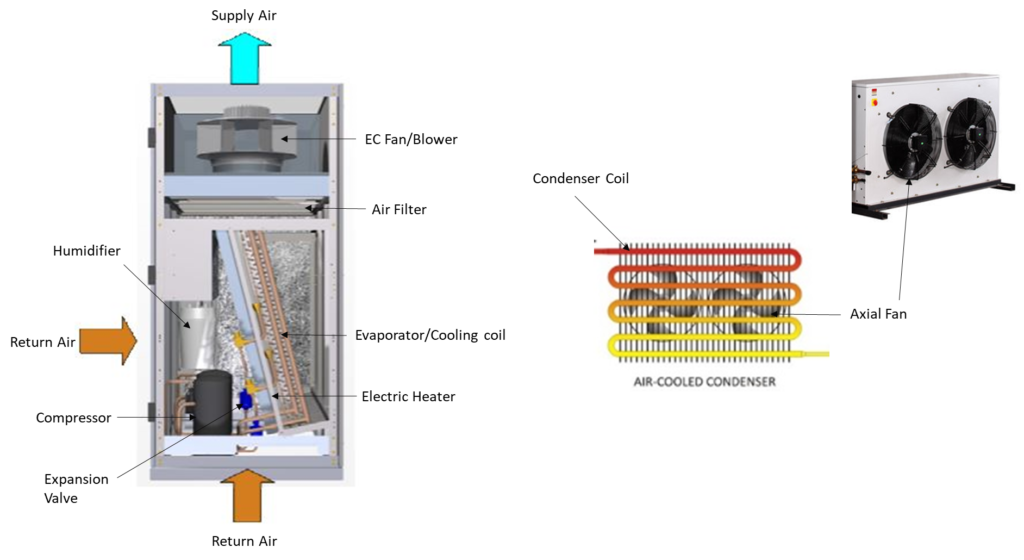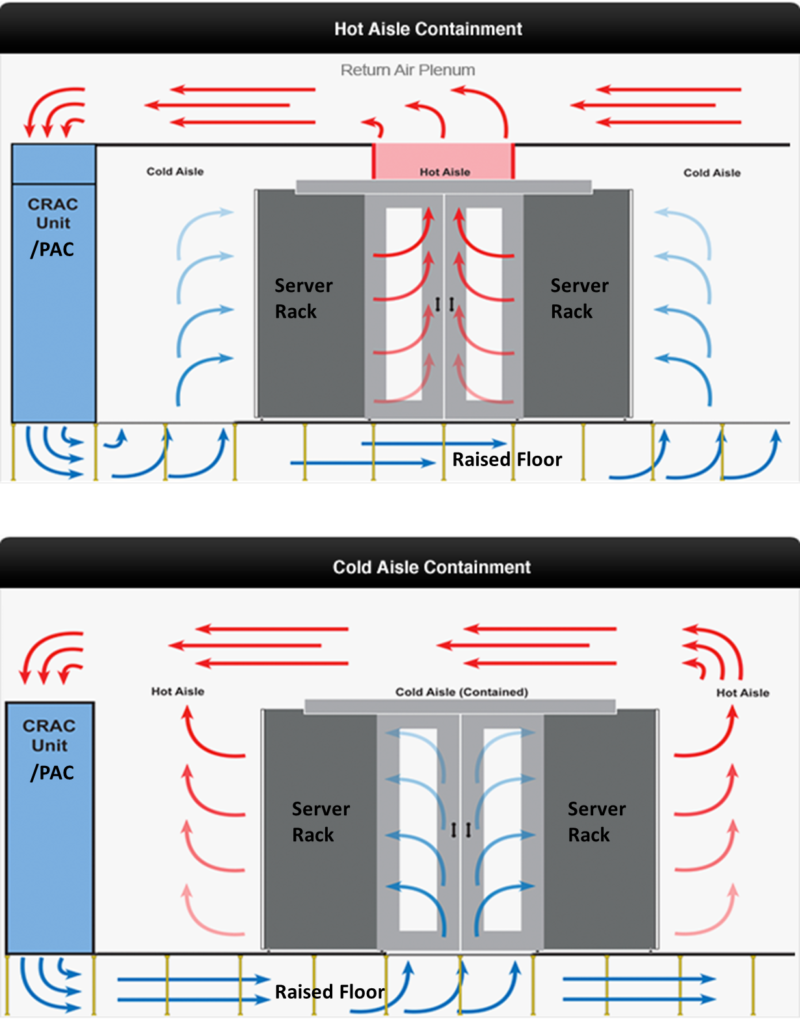
As the name suggest the precision control of temperature & humidity is achieved by precision Airconditioners (PAC’s). Unlike comfort application it is not for air-conditioning of people but it is used for cooling of high heat generating IT & electronic equipment’s, with a capacity of maintaining a tolerance limit of +/- 1°C in temperature and +/- 2% in Relative Humidity. This system works on high sensible heat ratios.
Sensitive electronics must be maintained in a stable environment of 20 – 25°C temperature with a relative humidity of 40% to 55% all- round the year. The computers and electronic equipment generate large quantities of heat in small areas, nearly 6 to 10 times the heat density of normal office space, the air conditioning system must have more than just enough cooling capacity. It must have the precision to react quickly to a drastic change in heat load and prevent wide temperature and humidity fluctuations.
PAC’s are widely used in below application:
- Data Centers
- Laboratories
- Telecom industries
- Hospitals etc.
Since the appliances like IT servers are operational 24/7 , the PAC systems also has to work for 24/7 round the clock.
COMPONENTS OF PRECISION AIRCONDITIONERS

Indoor Unit
COMPRESSOR: These units are equipped with higher efficient scroll compressor/ Digital scroll compressor or Inverter Scroll compressor on demand. Features low vibration, low noise and high reliability which works 24/7. Unlike Comfort AC compressor in PAC system are fitted inside Indoor unit only.
EVAPORATOR: Finned tube evaporator with high heat dissipation efficiency is used. The distributor, with its model-specific design, ensures that the refrigerant is distributed evenly in each loop, improving the evaporator efficiency to a great extent.
THERMAL EXPANSION VALVE – The external equalizer type thermal expansion valve collects temperature and pressure signals at the same time, so that it can regulate the refrigerant flow more accurately. Electronic expansion value can also be used for enhanced performance.
HUMIDIFIER/DEHUMIDIFIER/ELECTRICAL HEATER – Humidifier or dehumidifier fitted in the unit is adjustable to a wide range of water qualities, with fast start-up and high humidifying efficiency important in order to control the static electricity in the air. Electrical Heaters are used to lower humidity of space.
EC FAN – The system uses centrifugal backward or forward curve EC (electronically controlled) fan with high efficiency and reliability, large airflow and long blowing distance. This are very low noise fans.
AIR FILTERS– High efficiency Air filters are used to remove dust & other particles from supplied air.
FILTER DRIER – The filter drier can effectively eliminate the moisture in system within a period of time, filter the impurities generated during long-term system operation and ensure normal system operation.
MICRO-PROCESSOR CONTROLLER– Each Precision AC is equipped with an advance microprocessor controller
The controller is a microprocessor programmable logic controller. It has Separate indication of operating modes (cooling, heating, humidifying and Dehumidifying), alarm conditions (temperature high, loss of sensor, Compressor HP & LP, wet floor, no air flow and low humidifier water).
ROOM TEMPERATURE AND HUMIDITY SENSOR-Room Temperature and Humidity level to be set in the Microprocessor Controller for the desired condition to be maintain in the Room. Pressure sensors in the floor void to precisely control the supply rate, placing temperature sensors on the intake grills on the server rack is recommended to control the supply temperature from the CRAC units as this matches the actual intake.
Outdoor Unit
CONDENSER COIL- The outdoor condenser unit consists of Fin tube type condenser coil where hot refrigerant transfers heat energy to the atmosphere which was collected from the space to be cooled.
CONDENSER FAN-High efficiency Axial fans are used to blow outside air over condenser coil for effective heat transfer.
TYPES OF PAC
Based on Fluid used
- DX PAC – Uses refrigerant as cooling medium mostly R410a, R407C
- Chilled water PAC -Chilled water is supplied to cooling coil from chiller.
- Dual Fluid PAC- Two cooling coils are provided one for refrigerant & other for chilled water to make sure backup in case of any one system fails. Mostly DX system are operational & chilled water coil is provided as backup.
Based on Air discharge
- Bottom Discharge type
- Top Discharge type

WORKING PRINCIPLE

- Most common technology used with Precision airconditioners are Hot aisle or Cold aisle containment.
- IT room floors are raised to certain level (300 to 600 mm) to create void for movement of cooled supplier air or hot return air.
- The conditioned cold air will be forced by a fan in the CRAC/PAC unit into the void under the floor and small holes or grills in the floor tiles will allow the air to leave the void in strategic places.
- This air will collect the heat and rise up towards the ceiling. The PAC units then suck this warm air back into the unit to be reconditioned.
- The fan is usually provided in the cabinet of IT equipment which push hot air out & sucks cold air into the cabinet.
- Hot air from equipment are either collected above the ceiling or through the return ducting & supplied to PAC unit.
- This means the servers receive only fresh cold air and the PAC units receive the hot discharge air which increases the temperature differential across the PAC units heat exchanger and that will improve the efficiency of the machine.
- Room Temperature and Humidity level to be set in the Microprocessor Controller for the desired condition to be maintain in the Room.
- Pressure sensors are placed in the floor void to precisely control the supply rate.
- Temperature sensors on the intake grills on the server rack is recommended to control the supply temperature from the CRAC units.
- Best strategy to be used in positioning of server racks & PAC units to achieve highest efficiency from the system. Cold Aisle containment is recommended technology & most widely used in Data centers.
ADVANTAGES OF PRECISION AIR CONDITIONERS OVER COMFORT/STANDARD AIR CONDITIONERS:
- Precise and quick processor-based temperature control, to keep your IT equipment at the right temperature, always.
- Precise humidity control. Electronic devices require a steady level of humidity for proper functioning. Both high/low humidity levels can impede them on the long run.
- Designed for 24 x 7, 365 days continuous operation. Room air conditioners are generally designed to be used for a few hours, that too during summers.
- Precision air conditioners are designed to manage high levels of sensible heat (heat without humidity, emanated by machines) while comfort/standard air conditioners are designed to manage latent heat (heat with humidity, emanated by people).
- Precision airconditioners demonstrate better air distribution. They have higher CFM rates that movies more air volume at higher speeds than standard AC’s. That also means that there are less airborne particles due to the AC.
- Precision airconditioners can handle higher heat and AC load densities per each unit.
- For larger premises, several units of precision air conditioners can coordinate with each other and automatically control (increase/decrease) individual AC loads, for efficient cooling.
- Precision airconditioners can deploy new features or enhance existing ones as their software/firmware is regularly updated.
- Precision air conditioners have better, faster support facilities/contracts, as vendors specialized for them understand the critical nature of IT support and maintenance.
- It is also possible to remotely monitor/troubleshoot precision air conditioners, for quick problem resolution.
1 thought on “How Precision Airconditioners Works”